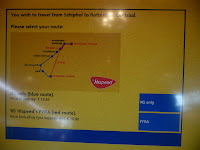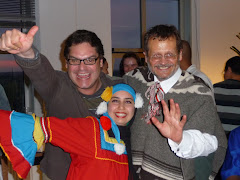Hmmm lets see....I think I might just have something for you. How about a visit to Madurodam. Madurodam is a miniature city located in Scheveningen, The Hague, in the Netherlands. It is a model of a Dutch town on a 1:25 scale, composed of typical Dutch buildings and landmarks, as are found at various locations in the country. So in essence it scales down the Dutch experience and distills it all into one "City". Its a pretty cool tour and by train its only 20 minutes on average to the Den Haag HS station from Rotterdam (NOTE: not the Den Hague station) at a cost of $8.20 return and only $4.90 (40% discount with the NS discount card- put discount in the search bar for more on that). A trip via tram from the station to Scheveningen which takes only another 20 minutes and you are there. You'll see minature representations of all landmarks in Holland so as the year passes the neat thing to do is try to see how many of the actual sites you can visit. We've look at some in older posts and will add to future posts.
No I won't tell you how to get to Scheveningen....come on guys...gots to leave some mystery for you to discover and explore - the address is George Maduroplein 1 2584RZ Den Haag. Entry fee € 14,50 and if you gather a bunch 20 or more students its € 10,25. Opens at 9am every day but closing time varies. Between Sept to March its usually 18:00; April to June at 20:00 and July - Aug at 23:00.
To the left is a map (click to enlarge) of the entire walking tour, of which there are two thematic routes you can choose to take. The Water Route and/or the Architecture Route.
To get a preview of what's in the offerings, you can visit youtube at http://www.youtube.com/watch?v=y0cZYR8SLKc&feature=related for a 5 minute viewing.
SCENARIO TWO - It's too far Jeanette...the paper is due tomorrow and we really can't afford more than a two hour break but I'd like to get a little further than a game of pool in the common room. No problem, I gots a solution and guess what just like Madurodam you can go and sense no guilt as you are still observing Cities in Action and contemplating urban management...LOL. Another mini city experience is Railz MiniWorld and its only 4 minutes walk from the Weenapad. That's right. Even easier on your conscience if you have studying Sustainable Transporation cuz its all about that oh so critical challenge of moving people from one part of a city effectively to enhance productivity and at reduced cost, congestion and impact on the environment. Now with that sales pitch here's what it offers.
Covering 500 m2, Railz Miniworld is the largest indoor model railway network in Holland. More than 100 model trains travel around over 2 kilometres of rails! Fully automatic model cars also drive among the many buildings; every 30 minutes the overhead lights are dimmed while a thousand tiny lights illuminate the mini world. This lively and interactive model world is the ideal chill out spot for a time out with a self serve restaurant and a small cinema. Cost is only € 9,25. Closes at 5pm so its more than likely a weekend visit and it opens at 10am. Its close, its affordable and its all about the City of Rotterdam scaled down but equally delightful.
 |
| The RailzMiniWorld Bld...look familiar? Its the same building you live on :-) |
SCENARIO THREE - But its already 7pm and its too late to go out of Rotterdam but its Friday or Saturday nite and you need some air. Well how about an evening at Watts (formerly knows as Nightown) the hippest coolest club in town. Turns out its only 10 minutes walk from Weenapad and the reviews from students have been good. I for one, am not a clubber so I can't speak to that but I did attend once as its not just a club but a venue for concerts. I saw the most awesome reggae concert with Taurus Riley and Duane Stephenson and oh man, it felt like I was right back there in Kingston 5 hangin with ma yardies. But I digress, so one way to keep in touch with what's on and happening at Watt's is via their Facebook page. The address is West-Kruiskade 26-28 3014 AS Rotterdam which is the road parallel to the Weena (the road you take from Central Station to the Apt). So have fun and don't miss the reggae shows y'all they are the bomb!!
West Kruiskade showing Watts on the left
Now I mention Watts because its close and many students have opted for that convenience BUT there are others you can google for additional info - Club Vie, Rotown and Club Elit. Well that's it for today folks....hope it helps, til next time.~JC



















